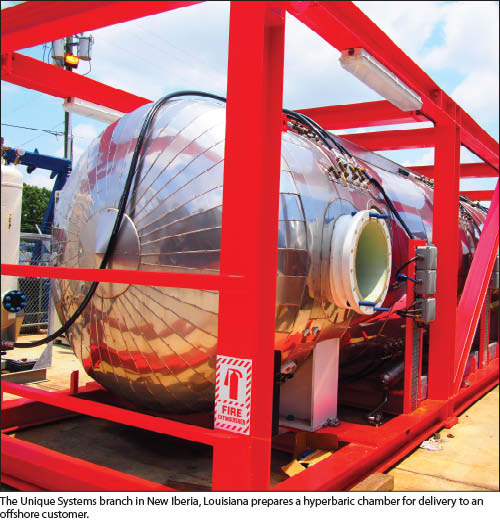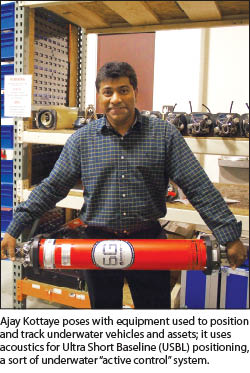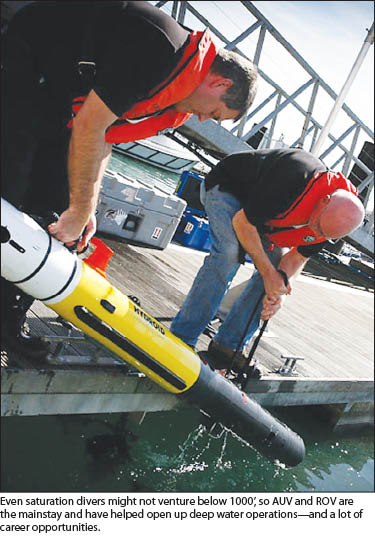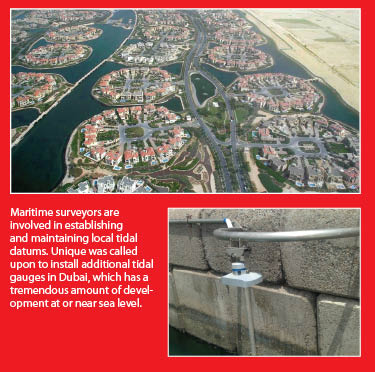This look at an international company that provides hydrographic surveying supplies and solutions reveals how surveyors can also ride the maritime boom. This particular day in the field has been hard. Precise levels are always a challenge to run, and the surveyor is weighing his options. First, he sets his level down at the first point and waits for a reading—so far so good. He slowly turns and begins his journey to the second waypoint, making sure to hold his instrument upright to maintain a good calibration. He raises his right arm to the second reference point, when he loses all control—a shark, disgruntled by the pinging of his echo-sounder, tears his left hydraulic line and renders the water thick with fluid. Back in the control room, the surveyor takes his hand off the joystick he uses to direct the motions of his robotic counterpart thousands of feet below.
This particular day in the field has been hard. Precise levels are always a challenge to run, and the surveyor is weighing his options. First, he sets his level down at the first point and waits for a reading—so far so good. He slowly turns and begins his journey to the second waypoint, making sure to hold his instrument upright to maintain a good calibration. He raises his right arm to the second reference point, when he loses all control—a shark, disgruntled by the pinging of his echo-sounder, tears his left hydraulic line and renders the water thick with fluid. Back in the control room, the surveyor takes his hand off the joystick he uses to direct the motions of his robotic counterpart thousands of feet below.
The robo-surveyor may be controlled by a joystick and the automatic level replaced by a pressure sensor, but the basics of surveying still remain a constant, even deep beneath the waves. There is a surveying revolution occurring under the ocean, fueled by the need for energy, the need to mine the depths for rare metals, and the need to better understand our physical world.
Although we land-bound surveyors are familiar with the tools of our profession, we might not have been exposed to the tools wielded by our marine and hydrographic surveying cousins. Their numbers have been swelling; one oil company estimated that they would need to add more than 500 ROV (remotely operated vehicle) operators in a single year, just for domestic operations. These are surveyors, performing many of the same tasks as would be done on land, but within an environment that is almost as alien and foreboding as outer space. The work is not all robotic: there are divers, pressurized enclosures, jigs and rigs.
PSM has been taking a deep look into this booming field. To better understand the tools, I visited one of the leading suppliers of equipment and solutions for marine and hydrographic operations, Unique Systems.
A Unique Company in Houston
 The Unique Maritime Group was founded in 1993, with origins in a surveying supply firm. The company moved headquarters to UAE, and expansion was fast and broad; the offshore industry proved to be a burgeoning field with many opportunities. The first branch office in the United States was opened in 2005, housed in New Iberia, Louisiana. In 2007 a Houston, Texas branch opened, specializing in the rental and sales of hydrographic surveying equipment. The company just celebrated its 20th year, and, under the dynamic leadership of Harry Gandhi, is riding this marine surveying and operations boom.
The Unique Maritime Group was founded in 1993, with origins in a surveying supply firm. The company moved headquarters to UAE, and expansion was fast and broad; the offshore industry proved to be a burgeoning field with many opportunities. The first branch office in the United States was opened in 2005, housed in New Iberia, Louisiana. In 2007 a Houston, Texas branch opened, specializing in the rental and sales of hydrographic surveying equipment. The company just celebrated its 20th year, and, under the dynamic leadership of Harry Gandhi, is riding this marine surveying and operations boom.
The setting of Unique’s Houston office is typical of the region’s fast-growing business climate. Situated in a complex with other tech and industrial solutions companies (but few are in hydro surveying), this location is the unassuming nerve center of the hydrographic surveying parts operation. It is from here that parts are rented out and refurbished, inspected, and often customized and improved.
“We have been supplying hydrographic surveying equipment to this market since 2007, and the amount of surveying work to be done just keeps increasing,” says Don Murphy, one of the solutions managers.
This location is where the business is done, where Unique rents out equipment and inspects the devices returned by clients. A good deal of their stock is related to acoustic positioning, using USBL (ultra short baseline) devices. These devices are able through sound waves to determine where they are; a ship fitted with one can determine the position of an underwater vehicle thousands of feet beneath the waves. This is done by a simple transfer of location. The vessel, through combined GPS-inertial-accelerometer systems, knows its position, heading, pitch, roll, and heave; it is then a matter of finding out where the underwater vehicle is relative to the ship, which is done through these sensors and transponders.
No Smoke and Mirrors
 There are many different types of sensors, and technological advances are constantly being championed by the various sensor companies. With this type of advancing technology, it is often easy to get caught up in the latest and greatest, even if it isn’t what your customers need. But sometimes it is only a matter of time until they realize they do. “When we think about what equipment to supply, we ask our customers. Sometimes what they need isn’t the newest, most exciting technology, but the devices that work best for them,” says Ajay Kottaye, who spends a lot of time paying attention to the needs of his customers.
There are many different types of sensors, and technological advances are constantly being championed by the various sensor companies. With this type of advancing technology, it is often easy to get caught up in the latest and greatest, even if it isn’t what your customers need. But sometimes it is only a matter of time until they realize they do. “When we think about what equipment to supply, we ask our customers. Sometimes what they need isn’t the newest, most exciting technology, but the devices that work best for them,” says Ajay Kottaye, who spends a lot of time paying attention to the needs of his customers.
The way these sensors work is changing, as new methods of retrieving data are often still under development. Major developments in offshore surveying are related to what companies do with this data once they’ve gained it. A new generation of post-collection surveyors are being bred, extracting from massive quantities of data vital information—a new wave of innovation in analysis.
Through the Back Door
The other half of Unique’s marine services facility is a cavernous warehouse where all of the ingoing and outgoing equipment is analyzed and checked for mechanical and computational robustness. There are safety-of-life considerations for dive-related equipment, and failing robotic gear can hold up critical operations, costing six figures per day. This machinery undergoes intense inspection any time it is returned to Unique after being rented out; the various underwater sensors can be rented only if they pass all of the required tests.
This shop processes many different kinds of acoustic sensors: the USBL units for positioning, multibeam sonar for detailed surveys of the sea floor, and gyroscopic navigation units so sensitive that they are subject to strict export controls—these tilt, pitch, and roll sensors are the same models used in cruise missiles.
Hands On
Sometimes, even with all of the high-tech equipment, there is no other solution than to send humans into the water. When the conditions are too unpredictable, the visibility is too low, or the job required is too precise, special deep-water divers are called in to perform the operations by hand. Metrology is a common occupation for these divers, requiring surveying techniques in order to determine the locations of pipes, where to place new infrastructure, and any other measurement that needs to be performed by a human. In extremely deep water, this means working with hundreds of feet of water above their heads—requiring long transfer times from the top of the ocean to the bottom and incurring the effects of working at such pressures for long periods of time. Decompression sickness, or “the bends” is a dangerous disorder resulting from spending long periods of time under high pressure and then quickly transferring to the surface without any transitional period.
One solution is to install hyperbaric chambers on the work vessels. These tubular compartments house teams of divers on the surface at the same pressures they experience underwater. A small diving bell first latches on the chamber, allowing the team to climb in. As it is connected to a crane on deck, the team is detached from the larger chamber and lowered into the water to complete their job. These chambers are extremely specialized and require great expertise to design and fabricate, and this is the specialty of Unique’s other United States office.
The Unique Systems branch in New Iberia, Louisiana deals in all of the aspects related to placing people underwater, and the building hosts a large fabrication facility that can rent these devices to other companies. The pace of equipment rentals is much less frantic for these large chambers—the company usually knows 8-10 months ahead what they will need to prepare.
Search and Recovery
 One large aspect of marine surveying is searching for lost equipment under the water: surveying large swaths of ocean floor to discover the location of lost objects. Once they’re found, however, it is hardly trivial to transfer these often large and heavy pieces of equipment back to the surface. Unique Systems has recently introduced the Sea-flex system of air lift bags, to be attached to an underwater object and inflated; with enough of these bags, the object will then rise to a waiting recovery vessel.
One large aspect of marine surveying is searching for lost equipment under the water: surveying large swaths of ocean floor to discover the location of lost objects. Once they’re found, however, it is hardly trivial to transfer these often large and heavy pieces of equipment back to the surface. Unique Systems has recently introduced the Sea-flex system of air lift bags, to be attached to an underwater object and inflated; with enough of these bags, the object will then rise to a waiting recovery vessel.
A marine surveyor, whether a diver or ROV jockey, is an expert at working at those depths and is called upon to do many tasks, including deployment of these recovery systems. This is definitely a branch of surveying that can be filled with adventure.
More Geospatial Adventure, Worldwide
Experts in these fields may find themselves working all over the world and on some interesting lateral projects. Unique has recently reached an agreement with the city of Dubai to install tide stations to determine a seal level datum. The city already has five tide stations, and the additional data gathered over the next 19 years will help the area surveyors develop the land with a greater understanding of the elevation and location of the various projects.
This push for more stations is a trend mirrored all over the world, due to a realization that these developing areas are in need of accurate and precise survey data. Even more importantly, there is a growing need for surveyors to analyze and develop proper reference systems based on this data.
Gotta Wear Shades
The future looks bright for companies like Unique Systems—offshore surveying, especially regarding oil and gas, shows no sign of letting up. Another driver of the marine surveying boom is offshore mining for rare metals, like those used in the production of solar panels and in support of the installation of offshore wind farms. The experience and techniques of traditional land surveying have been proven to translate all the way from the highest mountains down to the deepest depths, again being the silent profession powering the advancement of exploration and production. Many companies are beginning to see opportunities in supporting hydrographic exploration, and this up-and-coming field will lead new people to our field by instilling in them the basics of surveying, whether the environment is surrounded by air or water. After all, if certain fundamentals of surveying transfer from land to water, the opposite might also be true.
